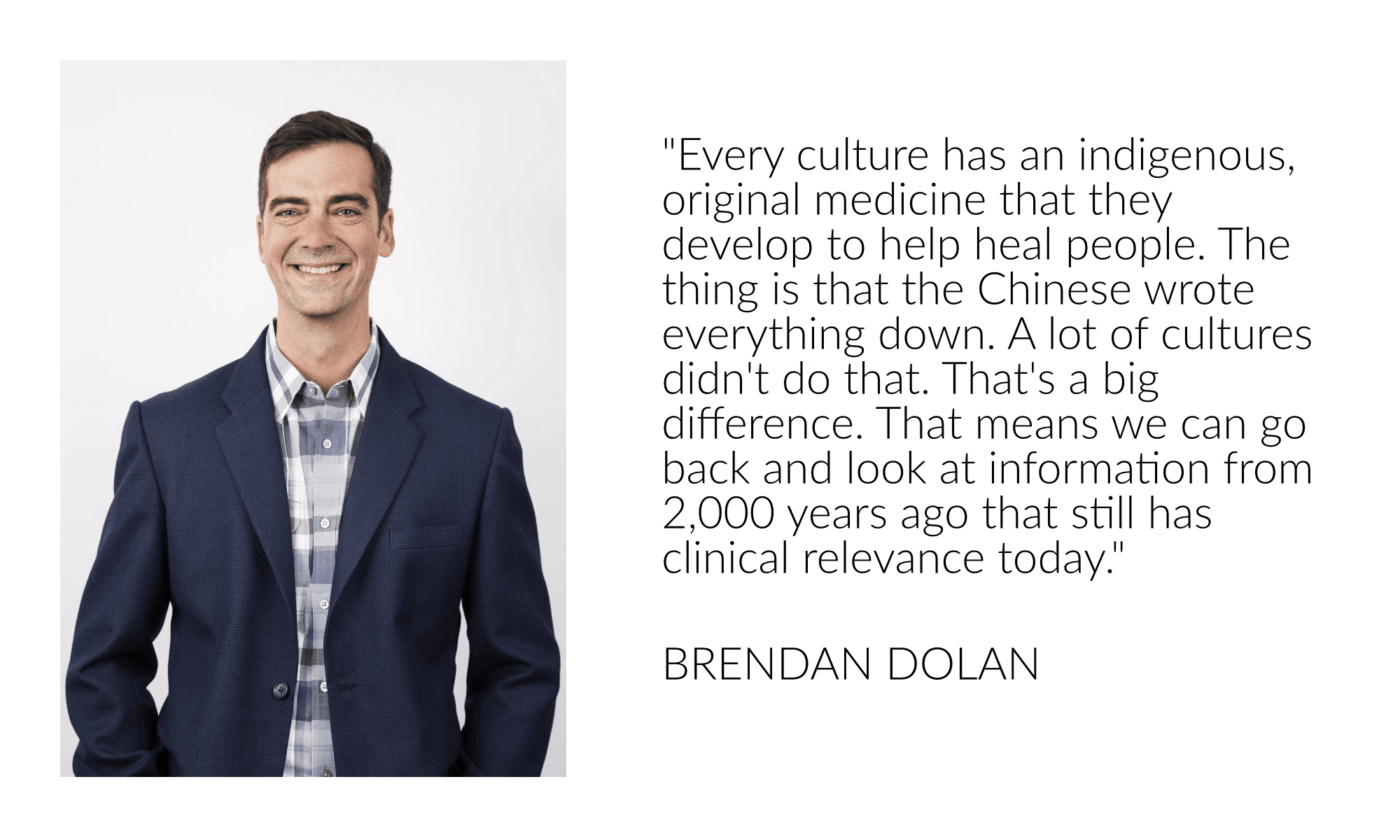Brendan Dolan is a recently registered Acupuncturist and Traditional Chinese Medicine practitioner working with Ryan Tze-Wai Longenecker out of their Avenue Acupuncture Clinic in North York.
He claims he’s afraid of needles.
Perhaps this is why he very generously offered to give me a free acupuncture demonstration as an accompaniment to our conversation. Lots of people are wary of having little, pointed things stuck in them, and I think he hoped that a written account of an actual ‘needling’ session might allay some fears.
Avenue Acupuncture is located at 1896 Avenue Road, in one of those upstairs-only offices with a front door so modest and shy, that I nearly walked past it. Inside and up the stairs, the office is a light, serene place with interesting artwork on the walls and meditative music playing the background. Various credentials and awards (the clinic has won the Consumer’s Choice Award four years in a row now) decorate the wall in one of the treatment rooms, along with a shelf full of dried, crystallized herbals.
[fvplayer src=”https://www.youtube.com/watch?v=E6_8DwN0g6M” splash=”https://i.ytimg.com/vi/E6_8DwN0g6M/maxresdefault.jpg” width=”780″ height=”450″ caption=”About Avenue Acupuncture”]
This isn’t a ‘high-volume’ clinic, Dolan explained after I arrived, but they can be fairly busy and some patients come from as far away as Europe to see Mr. Longenecker, who is a very rare specialist in degenerative eye diseases. Before you ask, yes; they are treated with acupuncture, and no, the needles don’t actually go into your eyes.
Since this was a one-off demonstration, Dolan decided to put me through what he called a ‘feel good’ treatment, designed to bring a sense of calmness and well-being. This involved lying on something a bit like a massage table while Dolan carefully placed needles in my arms, legs, feet, and forehead.
Although not every needle was completely painless (apparently, they can hurt if they hit a stressed or ‘blocked’ area), none of them were much more than a prick, and most weren’t even that. One or two I simply didn’t feel at all. I was, however, a bit disappointed by their size. I’ve always envisioned acupuncture needles as very long, elegant implements, but Dolan’s are tiny, short, disposable things no longer than a regular sewing needle, and much, much finer.
Once all the needles were in, the next phase of the treatment consisted of me lying still for 20 minutes while they did – whatever it is that acupuncture needles do. There are several theories, and all of them may be right. Dolan himself readily admitted that a large part of his craft is still, basically, a mystery. He knows what works, but he doesn’t always know why it works. The same is true in all branches of medicine if you dig deeply enough, but I’m not sure if many doctors are willing to admit it.
Sadly, I didn’t experience the almost euphoric reaction to the treatment that Dolan had said was possible, but I was certainly calm – dozing off on the table seems to be quite acceptable, and may even be encouraged. The office is even equipped with a heat lamp to keep your toes warm while you wait.
What’s your connection to Toronto?
I was born and raised in Toronto. I’ve lived here all of my life. And I’ve actually worked in this neighbourhood for some reason ever since my early teens. One of my first real jobs was working at Videoflicks which just closed down after 30 plus years across the street. Then when I graduated from university and I was looking for a job I worked at the Safari Bar and Grill. And here I am, almost 30 years later – I’m 44 now – still working in this neighbourhood. So there’s something about this strip. I have a personal connection to this strip.
You went straight from running a construction company to studying traditional Chinese medicine. How did that come about?
We did high-end renovations and custom homes. Once, when I was doing a job in Forest Hill, a ladder slipped and I fell down from the second-storey window onto the flagstone below. Luckily I didn’t break anything, but I did get pretty banged up; I was in a lot of pain. And there was an older framer that I worked with who was still doing this really heavy labour – whereas I was a bit more of a pencil pusher – and he gave me a list of the people who had helped treat him over the years. And from that I got exposed to Asian medicine; I was blown away by the results. I was just captured.
So I decided to make a mid-life career change. I went back to school for three years, full time. I did the Registered Acupuncturist program, [at the SSC Acupuncture Institute in Toronto] and then I did an additional fourth year of advanced studies for prescribing herbs and learning herbal formulas.
How did you end up back in your old stomping ground on Avenue Road?
For practical reasons, I wanted to be somewhere relatively close to where I live. I live near Bathurst and St. Clair, so I can get here in 15 minutes if I’m driving, which is great. I liked working in this neighbourhood, as I mentioned with my past history, it was very appealing to me to come back here and see some familiar faces and some of the same businesses still going here.
And Ryan and I developed a kinship because of continuously running into each other at these workshops. We kept going to the same workshops, then we started having lunch together, and I had one lunch with him and I thought ‘you know, I’d really like to work with this guy’, and thankfully he left the lunch thinking the same thing. And the rest was history. We have a good synergy together.
Tell me a bit more about your training. You did a lot of extra stuff.
I did as much as I could. I was very lucky I have my wife – it was very difficult, but she was able to support me. I figured if I was given this period of time, I was going to do everything I could to make the most of it. So I volunteered at a lot of clinics, I interned with a lot of people, and I went to every workshop on the planet until I found this one teacher about two years ago. And I was just captured, and now I follow her teachings almost exclusively.
Who was that teacher?
She grew up in Quebec, her name’s Suzanne Robidoux. She moved to China about 18 years ago, and she was trying to find these old teachers while there was still a chance. And after proving herself and mastering the language and dedicating herself, they realized ‘Ok, this person is unique. We are going to pass on this information to her’. Because what they’d come to recognize is if they get it back to the West, it’ll survive. Now Suzanne spends half of the year travelling around the world teaching people like myself, and the other half treating very severe neurological cases in China. MS. ALS. Parkinson’s. Stuff that we say is incurable. She’s my hero.
The type of medicine that you and Ms. Robidoux practice was in danger of dying out in China?
My passion – what I really, really, really love – is Classical Chinese medicine. Classical Chinese medicine is what existed before the Cultural Revolution in China. When the Cultural Revolution happened, all these great doctors who were associated with royalty or who treated the royal court or the emperor himself – they were put in jail, they were executed, or, if they were lucky, they got the most demeaning job possible.
So the story with Suzanne’s herbal teacher is; there was a guy named Wang Xian Zheng who treated the royal court. When the Cultural Revolution happened, he was given the job of teaching young children– not even teaching grade-school kids, that would be too high up. Just young, young kids. But he was smart. There’s a very famous book written about medicine, and it’s written in little paragraphs. He told the kids that they were like, little parables or nursery rhymes. And they would memorize them and recite them back to him.
And one of those students was Dr. Hu. Dr. Hu went on, grew up, had various different jobs, and he realized at some point with everything that was happening around him, that if he didn’t save this knowledge it would be gone forever. So he would meet, in private, illegally on Sundays, and he had this little group of students that he taught. Professor Hu, of course, is not alive anymore, but he taught Dr. Feng, and Dr. Feng taught Suzanne.
Acupuncture has become fairly mainstream in Canada now.
The industry has changed dramatically. About five years ago regulation came into play. So in the same way that somebody would say that they’re an RMT, or Registered Massage Therapist, now you’re an RAC, a Registered Acupuncturist, and or a Registered Traditional Chinese Medicine Practitioner. Those are the two designations that we have in Ontario. And that means that there’s an independent body, the College of Traditional Chinese Medicine Practitioners Association of Ontario, that regulates us on the public’s behalf. Their mandate is to make sure that I’m properly educated, that I’m treating people safely, that there’s professional conduct.. and if anything goes haywire and things aren’t good, it’s dealt with. And that’s changed things a lot. It helps us get coverage through insurance, which is growing, and that’s obviously important because the cost can be prohibitive for people.

The Avenue Acupuncture Clinic
What are some of the biggest differences between the traditional Chinese approach to medicine and what’s generally practised by Canadian doctors?
First off, it’s very old. Every culture has an indigenous, original medicine that they develop to help heal people. The thing is that the Chinese wrote everything down. A lot of cultures didn’t do that. That’s a big difference. That means we can go back and look at information from 2000 years ago that still has clinical relevance today. Also, several thousand years is a lot of troubleshooting. That’s a lot of time to kind of figure out what works in this case, what doesn’t work in this case. We just don’t have that history.
You know, modern Western medicine is mind-blowing with the stuff that they can do. My father had an irregular heartbeat recently, and they made a little incision in his groin, took a laser up to his heart, found the part that made the irregular heartbeat, zapped it, pulled it back out, and I picked him up that night. That’s mind-blowing, right? But it’s also mind-blowing that there are formulas based on liquorice that can treat irregular heartbeat, and are very, very effective.
The thing is – the way the Chinese medicine works is – it’s a pattern-based diagnosis. So one example I give people is headaches. So you have headaches, you want to get rid of your headache. You take an Advil, headache goes away. But for some people, the headaches keep coming back over and over again. And the Advil never gets to the root problem.
What’s unique about Chinese medicine – traditional Chinese medicine and Classical Chinese medicine – is we take that pattern which is unique to you. Where is your headache? Oh, it’s at the front of the head. Oh, no, it’s on the side. Oh, it’s on the top. It feels like this wet band around my head and I have trouble concentrating. These are all different diagnosis for us. And asking about sleep, your bowel movements, menses, your emotions… because all of these things are clues for us to find this pattern. When you can unlock the pattern, you get to the root cause. The person never has headaches again. It’s very individualized and personal, which I think is missing in some medicine… Now, that said, one thing I always emphasise is; I love Western medicine. I don’t think ‘Oh, give up Western medicine, just do this.’ I think they work amazingly in conjunction with each other.
Speaking of those 2000 years of troubleshooting, how has acupuncture evolved in modern times?
A great example would be a doctor in the United States who’s done a lot of work – contemporary work, some fascinating stuff – named Dr. Niemtzow. And he got in with the U.S. Navy. He developed something they called ‘Battlefield Acupuncture’. The idea is that you can use a specialized needle called an ASP. If you look at it under a magnifying glass it looks like a little arrowhead. And it’s gold plated. And what you do, is you insert it into specific areas of the ear. When you do this effectively and properly, the person’s pain instantly goes down from an eight out of ten to a two out of ten.
The needle itself is very very painful when it’s inserted. It’s not for the faint of heart. And it stays in for five to seven days, and then it will just naturally fall out. But during that time it’s giving constant stimulation to this area. And the U.S. Navy has done a ton of research on this to try to figure out why this is happening. So if you look at [an acupuncture chart of] the ear, there’s a map of the human body upside down. So when you needle in, say, the sacrum [lower back] area of the ear, it causes the same response in the body as if you actually stimulated the sacrum. And they’ve been able to show this. It’s wild.
Do you ever treat patients with ‘Battlefield Acupuncture’?
The last time I used that was for a patient who’s had migraines for twenty years. He doesn’t care that it hurts. He’s miserable. His life sucks. He can’t function. I said ‘let’s try this. It’s had really good studies done on it. It’s going to hurt, are you up for it?’ ‘Yes.’ It hurt, but his migraine was gone. But if you come in the first time I’m not going to be using ASP needles on your ear and torturing you. You’d never talk to me again. But in the right case that would be the right thing.
So where do the needles normally go?
In the classical system, it’s five points on six channels from the elbow down and from the knee down. That’s the only place you have to do. It will treat every part of the body and the internal organs.
But you also perform scalp acupuncture?
One of the things I specialize in is scalp acupuncture. With scalp acupuncture, we can treat neurological disorders like post-stroke paralysis. So I’m treating a post-stroke patient. We know that certain parts of the brain are associated with different things. There’s the motor line. This is fine motor control. This is the speech area. So I’ll needle in those areas, and we know that the right side of the brain controls the left side of the body, ok? So this patient has right-side paralysis, so I’ve been needling on his left. There’s a lot of redundancy in the brain, and by stimulating those areas and having the patient do a movement, you can re-light up those areas and they can get back movement much faster, or in cases where they wouldn’t get it back. His speech has improved, his gait, his walking, has all vastly improved. It’s an uphill battle, but it works.
What are some of the most common problems that you treat?
Pain is obviously a big one because we’re good at it, and so many people have problems with it. Fertility treatments are very popular. There’s a bunch of baby photographs at our front desk – Avenue Acupuncture Babies.
How do you treat the ‘untreatable’ conditions like Parkinson’s, ALS (Lou Gehrig’s Disease) and Multiple Sclerosis?
Scalp [acupuncture] and herbs. Scalp, body and herbs. But with neurological disorders, in my opinion, you need to include the scalp, because it’s a neurological disorder. But then, there’s a reason why that person has ended up there, and that really benefits from being treated internally. Tennis elbow? 100% you can treat with just acupuncture. Can you get faster results if you combine it with herbs? Definitely. Anxiety, stress, insomnia, all respond really well to acupuncture but can also be treated conjunctively with herbs. Eczema, psoriasis, complex skin disorders; much much much better and faster with herbs.
You’ve mentioned treating depression. How do you go about that?
It can be just acupuncture, but it works well with herbal too, because again, there’s always a cause. And we want to remove the cause. And usually, the cause is our diet and our lifestyle. A depressing diet is one that consists of a lot of dairy, a lot of cold-temperature foods, a lot of sugar, a lot of fat, and a lot of processed foods. Do you ever eat anything that makes you feel kind of clogged up? Like, phlegmy? Think of it, like, getting gummy in your mind. I have a particular interest in depression because I went through a fair amount of depression when I was younger. So, you know, if you can cure something in yourself and really understand it well both from the patient’s perspective and the practitioner’s perspective, then you can really empathize and you can really help.
25% off your first appointment when you book with Brendan!
JN00KV







